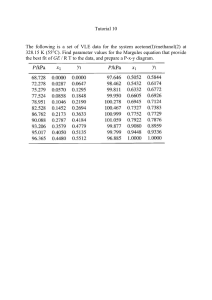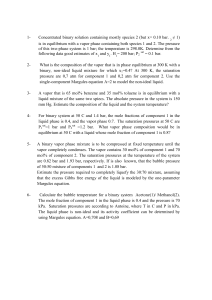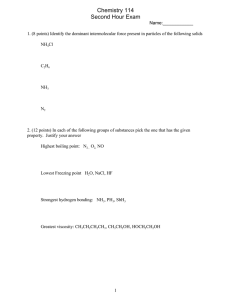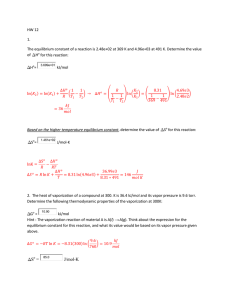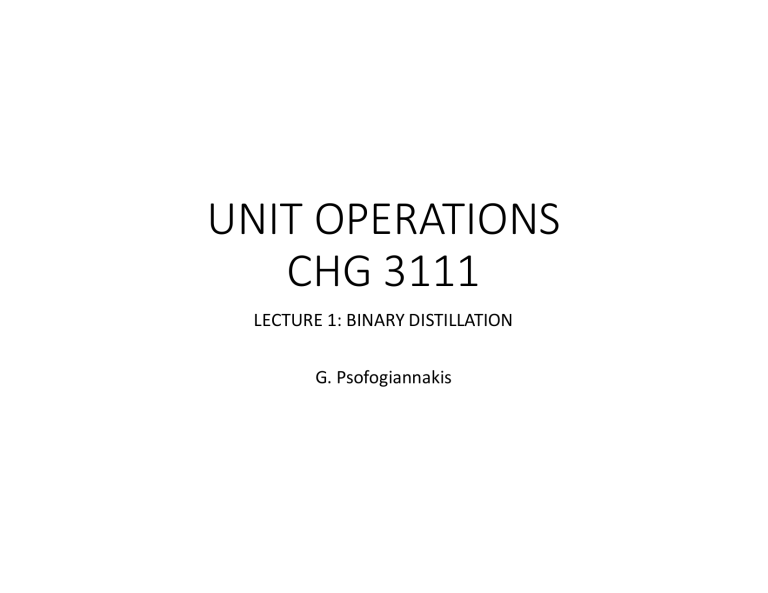
UNIT OPERATIONS CHG 3111 LECTURE 1: BINARY DISTILLATION G. Psofogiannakis GIBBS PHASE RULE GIBBS PHASE RULE: The number of degrees of freedom F (intensive variables that can be arbitrarily specified) in a non-reactive chemical system consisting of Π phases and C components is given by: F=2–Π+C • For two components (C=2) present in two phases (Π=2) at thermodynamic equilibrium: F = 2 • Consider Vapor-Liquid Equilibrium (VLE) (N=2) of a binary system (C=2) (such as a methanol-water mixture) • Methanol = Component A, Water = Component B • The intensive system variable are: T, P and the composition of the two phases: xA, xB=1-xA, yA, yB=1-yA T, P Composition: yA , y B Composition: xA , x B VAPOR VLE LIQUID • F=2 indicates that: - If the T and the P are specified, xA (and xB) and yA (and yB) are fixed (dependent) - If P, xA are specified, then T, yA are fixed - If P, yA are specified, then T, xA are fixed BINARY VLE • For the more volatile component (lower saturation temperature at P, light key: LK), yA > xA T, P Composition: yA,yB Composition: xA , x B VAPOR VLE LIQUID • For the less volatile component (higher saturation temperature, heavy key: HK), xB > yB • For the methanol – water system, methanol is the light key • Experimental data of the mol fractions of the boiling mixture in the liquid and vapor, are used and plotted in a T-xAyA diagram (T-composition phase diagram) at a given P. • The T-composition diagram has two separate lines: T vs x1 and T vs y1 for VLE at given P • The T-composition diagram for the Methanol – water system is shown in the next slide. • The relative volatility αA,B of the components is defined as: • It is a function of T, P and composition • It is a measure of the “easiness” of separating the components by distillation. BINARY VLE: T- COMPOSITION DIAGRAM TsatWater = Methanol (A)-Water (B) at P = 1 atm Vapor Region (Superheated) or ‘Dew-Point’ line • The T-composition diagram has both lines T vs xA and T vs yA at VLE • Bubble-point: The temperature where upon heating a liquid mixture, the first “bubble” of vapor appears • Dew-Point: The temperature where upon cooling a vapor mixture, the first drop of liquid appears or ‘Bubble-Point’ line Liquid Region (Subcooled) 64.5 = TsatMethanol • Endpoints on the diagram correspond to the boiling points of the components at P Mol Fraction of Methanol xA or yA • The mol fraction scale correspond to liquid or vapor depending on the state at each point • Points inside the envelope two-phase region can only represent the composition of the entire system (Liquid + Vapor), but not any individual phase. BINARY VLE: T- COMPOSITION DIAGRAM Tsat B = • As liquid A is heated, the bubblepoint is at B and the dewpoint is at D Methanol (A)-Water (B) at P = 1 atm • BB’ is a tie-line at 73.1 oC D’ • Point C is the overall composition (equal to that of A) when T = 78 oC. The liquid and vapor compositions are found at the endpoints of the tie-line D C B’ B A Heat • Point D (dew-point) vapor composition is yA = 0.5 (all liquid has vaporized). The composition of the last drop of 64.5 = TsatA liquid is at D’. 0.779 0.5 Mol Fraction of Methanol xA or yA Distillation: Separation method is based on the different volatilities of the components of a mixture. T-composition diagram: When the liquid is heated to point C, the vapor is enriched in the more volatile component . BINARY VLE: yA-xA DIAGRAM Plot of equilibrium mol fractions at P (The T-information is not used) The 45o-line (a line with equation yA=xA) is only for visualization – not an equilibrium line Light key (Methanol) equilibrium line is above the 45o-line. The T of the equilibrium line is decreased in the direction from left to right. Methanol (A)-Water (B) at P = 1 atm yA • • • • xA AZEOTROPIC MIXTURES T-y1 T-y1 T (oC) T-x1 T-y1 T-x1 T-x1 Chloroform (1) – Tetrahydrofuran (2) at 1 atm A maximum-boiling azeotrope Ethanol (1) – Toluene (2) at 1 atm A minimum-boiling azeotrope • When a mixture at azeotropic composition boils, the vapor composition is the same as the liquid composition. • The relative volatility of the mixture components switches (crosses the value 1) at the azeotrope • Thus, azeotropes cannot be separated by traditional distillation methods FLASH VAPORIZATION: A SINGLE-STAGE SEPARATION PROCESS OR • A single – stage continuous equilibrium distillation process in a flash-drum • If the feed is liquid is can be partially vaporized by T increase (heater) or P reduction (valve) or both • If the feed is vapor, it can be partially condensed in a condenser by T reduction or P increase. • At the flash drum the vapor and liquid are at thermodynamic equilibrium: - Therefore, PV = PL = P , TV = TL = T and yi, xi are related by the equilibrium relationship at T, P • Used for separation of components with large volatility differences FLASH VAPORIZATION: A SINGLE-STAGE SEPARATION PROCESS Total mass balance: F=L+V Component i balance: Fzi = Lxi + Vyi Energy balance: If Q = 0 adiabatic Subscript i refers to a component in the mixture T, P PV = PL = P , TV = TL = T FLASH VAPORIZATION: A SINGLE-STAGE SEPARATION PROCESS • Operating line or q-line: y1 = -(L/V)x1 + (F/V)z1 Subscript 1 refers to a component in the mixture L=F • The point (x1, y1) should belong to both the q-line and the equilibrium line • Try x1=y1 on the q-line equation: x1=y1=z1 y1 • Slope of the q-line: If L = 0 (V = F): slope = 0 y1=z1 L=0 L= V = F/2 If L = F (V = 0): slope = ∞ If L = V = F/2: slope = -1 • y1 is maximum for V = 0 (but at the limiting case of getting no vapor). x1=z1 x1
